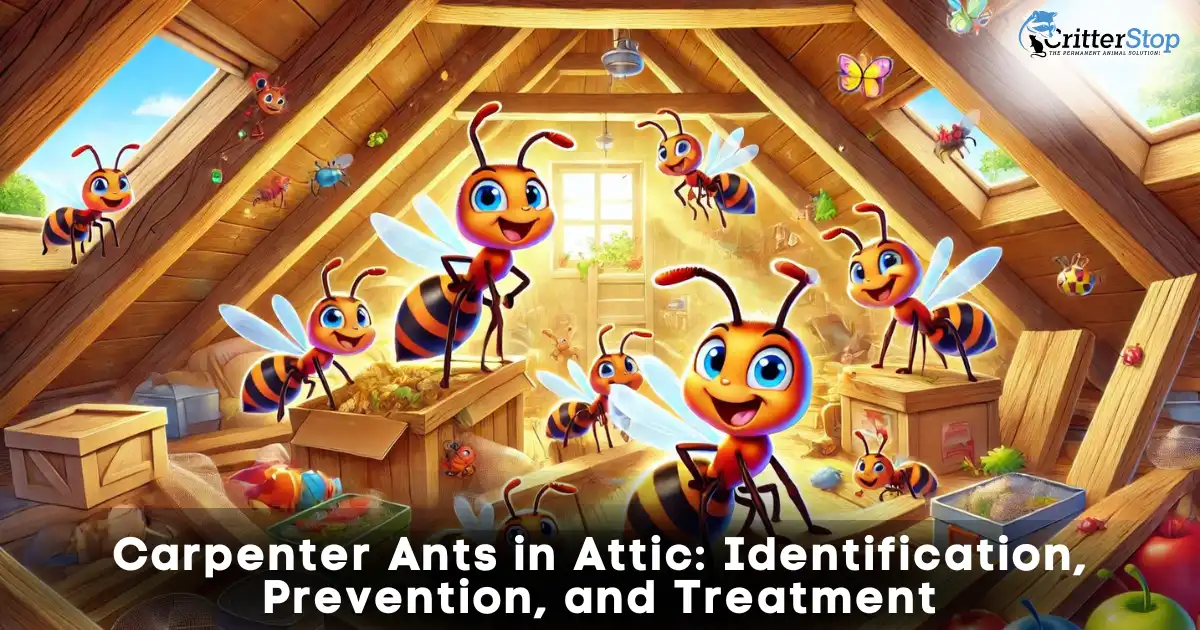
There are a lot of homes with carpenter ants, and the attic is one of their favorite places to live. People know that these ants can do a lot of damage to wooden buildings, and an infestation in the attic can be especially bad. This article will talk about carpenter ants in the attic and how to get rid of them. It will also talk about how to spot an infestation and the damage they can do.
Carpenter ants are a type of ant that is attracted to moist and decaying wood. They do not eat the wood, but instead, they burrow into it to create their nests. In the attic, they are often drawn to areas of the roof that have suffered water damage or are poorly ventilated. Once they establish a nest, they can cause significant damage to the wooden structure of the attic, which can weaken the roof and cause other structural problems. Identifying and dealing with a carpenter ant infestation in the attic is essential to protecting the integrity of the home.
If you don't get rid of carpenter ants, they can damage the attic and other parts of the house. Aside from the damage they do to the structure, they can also bring in other pests, like termites, that do even more damage. Finding the source of the infestation, getting rid of the ants, and fixing any damage they may have done are all steps that need to be taken to get rid of a carpenter ant problem in the attic. Homeowners can get rid of carpenter ants and keep them from doing more damage to their home if they know what to do and have the right tools.
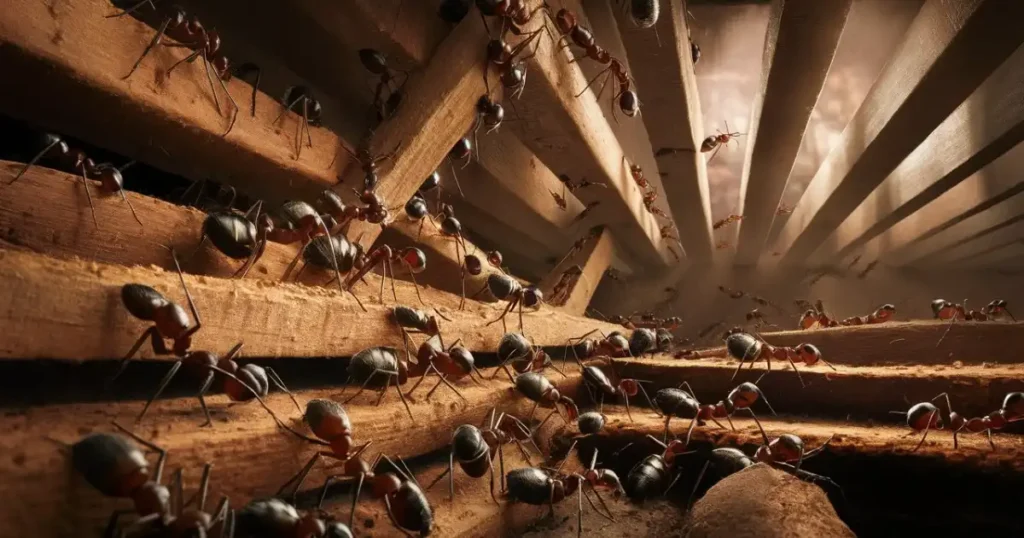
You can find carpenter ants all over the world. As everyone knows, these ants can build nests in wood, which can damage buildings and other things.
Carpenter ants live in wood that is both wet and dry. They like to build their nests in wood that is breaking down. Most of the time, you can find them in attics, crawl spaces, and place with wood. Carpenter ants don't eat wood, but they do chew it up to make routes and rooms for their nests.
Carpenter ants are most active at night and can often be heard rustling around in their nests. They are also attracted to sweets and other sugary foods, so it is important to keep these items sealed and stored properly.
Most of the time, carpenter ants are bigger than other types of ants. Their workers are between 1/4 inch and 1/2 inch long. They are mostly black or dark brown, but some species may have a hint of red or yellow.
One way to identify carpenter ants is to look for the sawdust-like material that they leave behind as they tunnel through wood. This material, known as frass, is a mixture of wood shavings, ant parts, and other debris.
Another way to identify carpenter ants is to look for their nests. Carpenter ant nests can be found in a variety of places, including tree stumps, logs, and the walls and ceilings of buildings. They may also be found in insulation, foam, and other materials.
In conclusion, understanding the habitat and behavior of carpenter ants, as well as how to identify them, is important for preventing and controlling infestations.
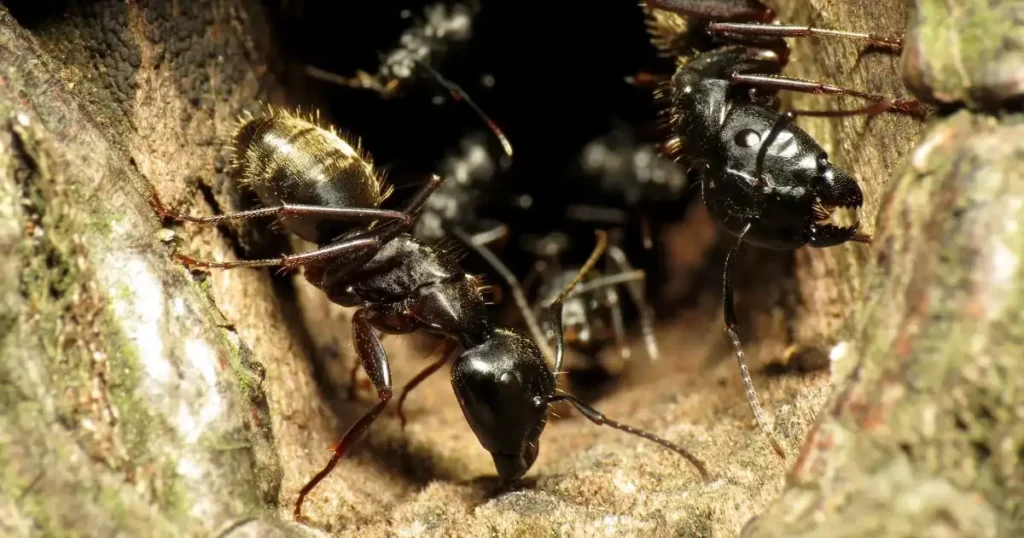
Having frass in the attic is one of the most common signs that you have carpenter ants living there. Frass is the sawdust-like material that carpenter ants leave behind as they tunnel through wood. It is often found in piles near the entrance holes of their nests.
If you notice frass accumulation in your attic, it is important to investigate further to determine the extent of the infestation. A small amount of frass may indicate a minor infestation, while a large amount may indicate a more serious problem.
Ant trails that can be seen are another sign that there are carpenter ants in the attic. Carpenter ants are social insects that live in big groups. They often follow clear paths between their nests and food sources.
If you see ants traveling in a line along the walls or ceiling of your attic, it is likely that you have a carpenter ant infestation. It is important to follow the trail to locate the nest and determine the extent of the infestation.
Carpenter ants tunnel through wood to make their nests. This can damage the wood over time. You should look into further to see if carpenter ants are the cause of any wood damage you see in your attic, such as hollowed-out or weak wood.
It is important to address a carpenter ant infestation in the attic as soon as possible to prevent further damage to your home.A professional pest control company can help you figure out how bad the problem is and come up with a way to get rid of the ants and keep them from coming back.
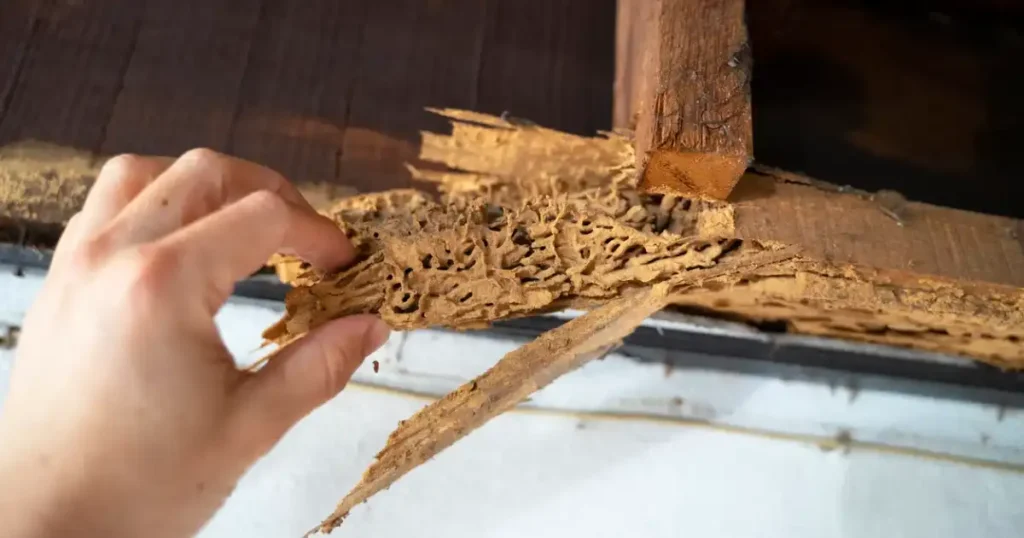
To keep carpenter ants out of the attic, you need to seal up any openings they could use. The roof, walls, and foundation should all have no cracks, gaps, or holes. Homeowners can use caulking, weather stripping, and foam insulation to seal these entry points. It is also recommended to install screens over vents and windows to prevent carpenter ants from entering through these openings.
Carpenter ants are attracted to moist and humid environments, so it is crucial to control the moisture levels in the attic. Owners of homes should check to see if the roof, pipes, or air conditioners are all leaky. They should also use dehumidifiers to reduce the humidity in the attic. Additionally, it is recommended to use a vapor barrier to prevent moisture from entering the attic.
Regular inspections of the attic can help detect carpenter ant infestations early. Homeowners should inspect the attic for signs of carpenter ants, such as sawdust, wood shavings, and ant trails. They should also look for any damage to the wood structures in the attic. It is recommended to inspect the attic at least once a year and after any major weather events.
By following these preventive measures, homeowners can reduce the risk of carpenter ant infestations in their attics. Sealing entry points, controlling moisture levels, and regular inspections can help ensure that the attic remains free of carpenter ants.
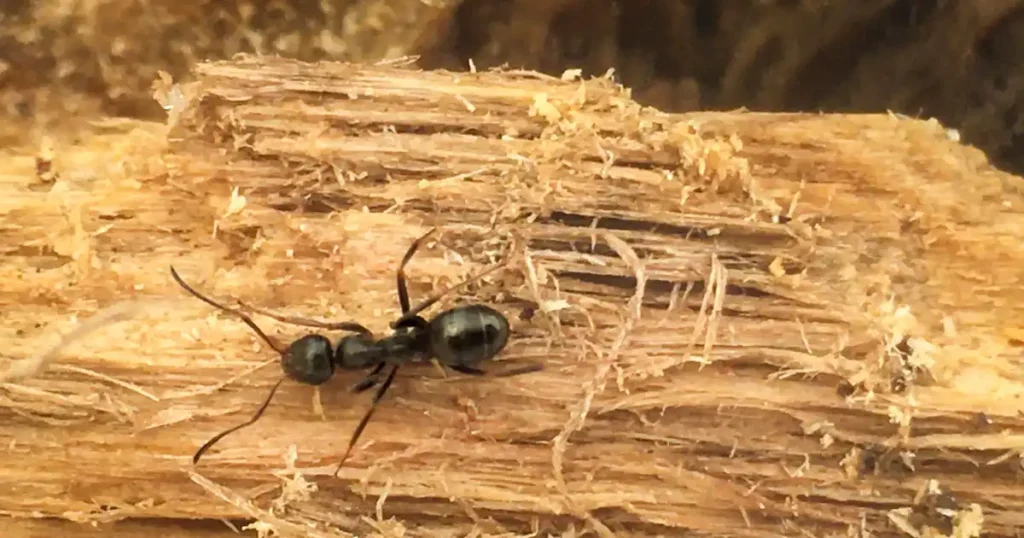
Essential oils have become a popular natural remedy for various pest problems, including carpenter ants in the attic. Cedarwood, peppermint, and tea tree oil are among the essential oils that have proven to be effective in repelling carpenter ants.
Use essential oils to get rid of carpenter ants. Mix a few drops of oil with water in a spray bottle. Spray the area where the ants are. Keep in mind that essential oils should not be the only way you get rid of bugs. They should be used with other methods instead.
Diatomaceous earth is a natural substance that won't hurt you and can be used to get rid of carpenter ants in the attic. Diatoms are a type of algae that have turned into a fine powder over time.
If you want to use diatomaceous earth, sprinkle it around places where there are carpenter ants. The powder will stick to the ants and dry them out, killing them in the end. You should only use food-grade diatomaceous earth, though, not the kind that is used for pool filtration, since that kind can be bad for people and animals.
Boric acid is something that you can find around the house and use to get rid of carpenter ants in the attic. You can find this white powder at most hardware stores. It is often used to get rid of pests.
To use boric acid, mix it with sugar or honey to attract the ants and place it in areas where they are present. The ants will consume the mixture and eventually die. But you should be careful when you use boric acid because it can hurt people and animals if they eat too much of it.
In general, natural remedies can help get rid of carpenter ants in the attic, but they shouldn't be your only way of getting rid of pests. To make sure the problem is fixed correctly, you should talk to a professional pest control service.
Carpenter ants in the attic can be effectively controlled using chemical treatments. There are several types of chemical treatments available, including insecticides, baits, and professional pesticides.
Insecticides are a common chemical treatment used to control carpenter ants. They are available in different forms, such as sprays, dusts, and granules. Insecticides contain chemicals that kill ants on contact or when ingested. To make sure that insecticides are safe and effective, it is important to carefully follow the directions given by the manufacturer.
Baits are another type of chemical treatment used to control carpenter ants. Foraging ants bring poison from baits back to the ant colony, where it works slowly. The poison is then shared with other ants in the colony, eventually leading to the death of the entire colony. Baits are an effective way to control carpenter ants, but they require patience as it may take several weeks to see results.
Professional pesticides are chemical treatments that are only available to licensed pest control professionals. These pesticides are more potent than those available to the general public and require specialized equipment and training to use safely and effectively. Professional pesticides are usually only used when nothing else has worked or when the infestation is very bad.
When using chemical treatments to control carpenter ants in the attic, it is important to identify the source of the infestation and apply the treatment directly to the nest if possible.Also, it's important to protect yourself and others from the chemicals by doing things like wearing protective gear and staying away from surfaces that have been treated.
Overall, chemical treatments may be a good way to get rid of carpenter ants in the attic. But it's important to use them properly and safely so that people, pets, and the environment aren't hurt too much.
If you need a pest control service because of carpenter ants in your attic, do your homework and choose a reputable company that has dealt with this kind of infestation before. Look for companies that have certified and licensed technicians, as well as positive reviews from previous customers.
It's also important to ask about the methods they use to eliminate the ants and whether they use eco-friendly options. Make sure to get a written estimate and ask about any guarantees or warranties they offer.
In order to get rid of carpenter ants in the attic, the property usually needs to be carefully inspected to see how bad the problem is. Based on what they found, the technician will then make a personalized treatment plan.
The treatment plan may include a combination of baiting, spraying, and dusting of the affected areas. It's important to follow the technician's instructions for preparing the area before treatment and to vacate the premises during the treatment process.
The technician will usually do another inspection to make sure that the infestation has been completely gotten rid of after the treatment is done. To stop future infestations, it's important to fix any underlying moisture problems.
Overall, professional extermination is the most effective way to get rid of carpenter ants in the attic. By choosing a reputable pest control service and following their instructions, homeowners can successfully eliminate the infestation and prevent future damage to their property.
It's crucial to determine the extent of the damage that carpenter ants in the attic have caused before moving forward with restoration. It's important to find all the places where carpenter ants have been because they can do a lot of damage to wood.
The first step in assessing the damage is to inspect the attic thoroughly. Look for signs of carpenter ant activity such as sawdust, wood shavings, and small piles of debris. These are indications of nesting sites and can help identify the areas that need restoration.
It is also important to look for signs of structural damage such as weakened beams, sagging roofs, and cracked walls. These are indications of long-term infestations and require immediate attention.
Restoring wooden structures damaged by carpenter ants requires a systematic approach. The first step is to remove all the damaged wood and replace it with new wood. This will prevent further infestations and ensure the structural integrity of the building.
Once the damaged wood has been removed, it is important to treat the surrounding areas with insecticides to prevent further infestations. This can be done by spraying insecticides directly on the affected areas or by using baits to attract and eliminate the carpenter ants.
After the insecticides have been applied, it is important to seal all the cracks and gaps in the wooden structures to prevent further infestations. This can be done by using caulking or sealants to fill in the gaps and cracks.
In conclusion, restoring wooden structures damaged by carpenter ants requires a thorough assessment of the damage and a systematic approach to restoration. By following these steps, it is possible to prevent further infestations and ensure the structural integrity of the building.
Regular monitoring of the attic for carpenter ant activity is crucial in preventing infestations. Homeowners should inspect the attic periodically, especially during the spring and summer months when carpenter ants are most active. Signs of carpenter ant activity include wood shavings, sawdust, and small holes in the wood.
To monitor carpenter ant activity, homeowners can place sticky traps or bait stations in the attic. Sticky traps can be put on the walls and in other places where carpenter ants are likely to go. Bait stations can be placed near areas where carpenter ants have been seen, and should be checked regularly for activity.
To prevent carpenter ant infestations in the attic, homeowners should take steps to eliminate moisture and wood decay. Leaky roofs, pipes, and gutters should be repaired to prevent water damage. Any damaged or decaying wood should be replaced.
Homeowners should also trim back trees and shrubs that are in contact with the house, as these can provide a pathway for carpenter ants to enter the attic. Additionally, firewood and other wood debris should be stored away from the house.
Regular maintenance of the attic can also help prevent carpenter ant infestations. Get rid of all the junk and clutter, and fix any holes or cracks in the roof or walls. Homeowners should also consider using insecticides as a preventative measure, but should follow all label instructions carefully and use caution when applying the product.
By regularly monitoring the attic and taking preventative measures, homeowners can keep carpenter ants at bay and protect their home from damage.
If you see big black ants crawling around or near the attic, see piles of sawdust-like material (called frass) next to wooden structures, and hear rustling or tapping sounds coming from the attic, these are all signs that you have carpenter ants in your attic.
To effectively eliminate carpenter ants from the attic, it is essential to locate and treat the source of the infestation. A professional pest control service can use specialized equipment and treatments to eradicate the ants and prevent future infestations.
Yes, carpenter ants can cause significant damage to attic structures. They can weaken wooden structures by tunneling through the wood to create nests, which can compromise the structural integrity of the attic.
To get rid of ants in the attic, it is recommended to hire a professional pest control service. They can identify the source of the infestation. So if you were wondering how to get rid of ants in attic, It is best to hire a professional pest control service to handle the infestation. They can identify the source of the infestation, safely and effectively eliminate the ants, and provide recommendations to prevent future infestations.
Carpenter ant nests in the attic can vary in appearance. They typically consist of tunnels and galleries that are excavated in the wood. The nest may also contain eggs, larvae, and pupae, which can be difficult to see without specialized equipment.
Carpenter ants are attracted to attic spaces because they provide an ideal environment for nesting. Attics are typically warm, dry, and contain wooden structures that can be easily tunneled through to create nests.
Carpenter ants and termites can be difficult to distinguish from each other, as they both tunnel through wood. However, carpenter ants have a narrow waist and elbowed antennae, while termites have a broad waist and straight, beaded antennae. A professional pest control service can help identify the pest and provide appropriate treatment.
Carpenter ants, known for their destructive tendencies and persistent presence, often invade properties with relentless determination.
However, when faced with the nuisance of carpenter ant infestations or the need for effective extermination services, the solution can be found with Critter Stop.
If carpenter ants are causing problems, such as damaging wood structures or invading your home, there are effective ways to address the issue.
At Critter Stop, we have provided our carpenter ant removal services for years in the North Texas area, helping customers to protect their family, pets, and property from damages.
Contact us at (214) 234-2616 to get a free estimate of our services.
Visit our Critter Library and learn more about our furry friends